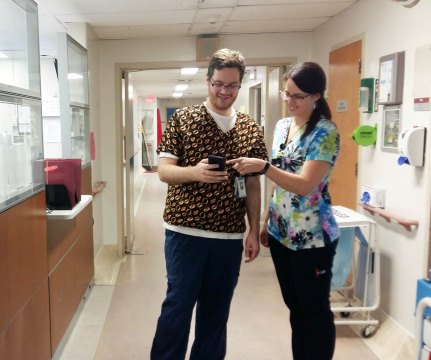By Julie Adams
In the past, if Liz Caterer, staff scheduler at Stevenson Memorial Hospital (SMH) needed to fill a shift she pulled out her long list of clinicians and settled in for an hour or two of making calls – now she just ShiftLinks it.
With the click of a button, Caterer can fill vacant shifts – saving her about two hours a day while simultaneously helping to enhance both staff morale and the patient care experience. “I co-ordinate the staffing for nursing across the hospital,” says Caterer.
“Depending on which department is short, I may have to call up to 25 people to fill one or multiple shifts per department, per day. Now I simply create a shift profile that can be segmented by time, employee status and department or location, and boom, the shift is posted.”
An innovative, cloud-based web and mobile application, ShiftLink helps organizations to eliminate the time, cost and frustration typically associated with the arduous process of filling vacant shifts. Once the software is implemented, staff download the free app directly to their smartphone, tablet or desktop computer to receive notifications about available shifts.
“We offer a unique technology platform that enables managers to communicate shift opportunities to frontline staff in mere seconds,” says Richard Bicknell, president, ShiftLink. “Managers don’t have to spend hours on the phone and staff no longer have to worry about missing a shift due to a missed call or unchecked voicemail – they simply get a notification through the app.”
This innovative technology has streamlined the shift-filling process from multiple disjointed steps to three simple actions: create a shift profile, hit send and approve the most appropriate employee based on seniority or fair shift distribution. Shifts are only sent to staff with matching profiles and a customized timeframe in which to respond. Responses are filtered back to the manager listed by seniority to help maintain effective labour-relations.
“The experience of scheduling – not only for the hospital, but for our clinicians from a personal perspective – has improved,” says Carrie Jeffreys, Vice-President of Clinical Services and Chief Nursing Executive at SMH. “It helps to make life more predictable in a business that runs 24/7, and by making the process easier, we are not running short which has a major impact on patient care.”
Paul Schaedlich, Manager, Environmental Services, at Markham Stouffville Hospital has had a similar experience. “It’s great to be able to notify the entire seniority list in one shot,” says Schaedlich. “Not only do staff have more time to respond to a shift, but also more time to get ready and get to work. Since implementing ShiftLink things have become a lot easier.”
In the past, Schaedlich spent 15 to 45 minutes filling just one vacant shift from his 120-person staff. Now he fills four or five shifts concurrently via the online platform while engaging in other operational work. Since launching in 2017, Shift-Link has helped its clients reduce time spent on the phone by 75 per cent equating to an annual average savings of about $400,000 in productivity alone, not to mention the savings associated with overtime and agency costs. With an average of four people responding per post, hospitals are provided greater choice of available and interested staff, thus avoiding the need to pay overtime or fill the shift through an external staffing agency, saving tens of thousands of dollars each year.
This is vital for an industry that provides acute medical care to thousands of Ontarians every day and is under constant strain to produce both cost and time efficiencies. At SMH, Jeffreys says the hospital had already been looking at the dated and wasteful process of filling shifts.
“We wanted to eliminate some of the re-work because it’s a waste of time for the system and for the person, and we value people’s time.” What she, and her team, discovered was more than a pile of inefficiencies; there wasn’t a mechanism in place to capture data and see where the process was breaking down. “ShiftLink captures all the data we need,” says Jeffreys. “We have a dashboard that allows staff, management and leadership to see what’s going on. This has led to more informed conversations about scheduling – how it functions and abides by union rules and how our process can be further improved.”
In addition to its convenience and simplicity, the app also features custom screens for staff and management, the ability to list staff responses in order of seniority, a history log to help manage shift-related grievances and support investigations, unlimited administrative accounts, and the ability to capture trend data for future staff and budget planning.
Ultimately, scheduling, which is a known pain point for most hospitals and shift-related industries, is now easier for shift schedulers and staff, leading to a more relaxed and positive work culture. “When you have happy staff, you have happy patients,” says Jeffreys.
*Sponsored content
Julie Adams is chief executive officer and co-founder of ShiftLink. She can be contacted at info@shiftlink.ca.


